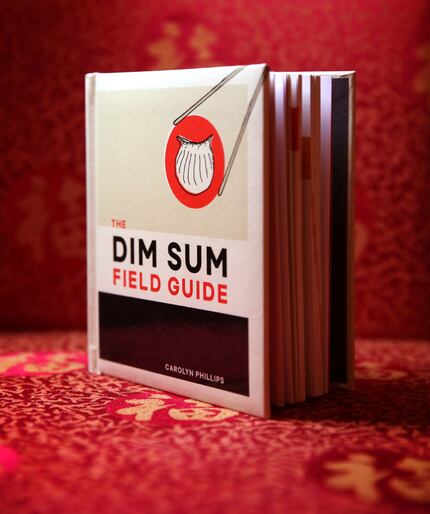"Let's go out for dim sum."
Why not? Cantonese-style brunch is one of the most delightful ways to spend a weekend late morning or afternoon.
But what if you've never had dim sum? How would you know how and what to order? Or what if you've done it a hundred times but want to branch out and discover dishes you've never tried, or want to make sure you're not offending anyone if you dip your dumpling in Chinese mustard?
{"type":"video","title":"Dallas News Video","author_name":"Dallas News","_id":"c3cjk2OTE6EhZfZGbNKhJufJl1XsRYeX","provider_name":"Ooyala","html":"
","raw":"{\"type\":\"video\",\"title\":\"Dallas News Video\",\"author_name\":\"Dallas News\",\"_id\":\"c3cjk2OTE6EhZfZGbNKhJufJl1XsRYeX\",\"provider_name\":\"Ooyala\",\"html\":\"\\u003Cdiv class=\\\"oo-vid-container\\\" data-oo-content-id=\\\"c3cjk2OTE6EhZfZGbNKhJufJl1XsRYeX\\\"\\u003E\\u003C\\/div\\u003E\\u003Cscript defer src=\\\"http:\\/\\/www.dallasnews.com\\/resources\\/motif\\/dist\\/js\\/ooyala.js\\\"\\u003E\\u003C\\/script\\u003E\"}","providerType":"ooyala","providerLink":"http://www.dallasnews.com/oembed","embedType":"video"}
Traditionally, dim sum, which can be translated as "snacks," are served from rolling carts that move through a dining room. Stopping at each table, the server lifts the lids from steamer baskets to show off dumplings or meatballs, or displays plates of barbecue pork or roast duck, gai lan ("Chinese broccoli") or sweet egg custard tarts.
You point to what you'd like, and the server places it on your table, stamping or writing on a sheet that keeps track of everything you've ordered.

Some carts offer single items, like congee (rice porridge) or house-made tofu.
No special knowledge is required to have a great time, as you can just point at what looks good; no need to know what the dishes are called or how they're made. But to make the most of the experience, it helps to know a little — which also can help you strategize and order wisely.
I've been eating dim sum pretty much my whole life — enjoying it in dim sum capitals from Hong Kong to Vancouver to New York to San Francisco and Southern California's San Gabriel Valley — so I already had a pretty good handle on what to order and how. But now a new book, The Dim Sum Field Guide by Carolyn Phillips, has filled me in on some background I'd been missing, including some of the history of the ritual and things like just what's in a char siu bao's filling, and the "default" sauces or dips for various dumplings.

According to Phillips, dim sum's origins were probably "in the north around one thousand years ago," but nearly every region of China has its own snack traditions. The style of dim sum we usually see in North America is Cantonese.
The only thing I don't love about the book is that it's illustrated rather than photographed, and the pictures of the dim sum are hard to recognize. Another little book, Dim Sum: A Pocket Guide, by Kit Shan Li, has less detail about ingredients, history and so forth, but there are fabulous photos of each dish. Either book, or both are helpful for those who want to learn more.
But you don't need them to dive in.
Ready to feast? Here's how it all goes.
First, order tea
As soon as you're seated — maybe even before you're all the way in your chair — you'll be asked what you'd like to drink. The idea is to drink tea, as dim sum were traditionally snacks served in tea houses, meant to go with tea. You can ask for jasmine tea, black tea, green tea, oolong tea, even — in some restaurants — chrysanthemum, lychee or pu'erh tea. Sip this throughout the meal.
Hey, here comes a cart!

My biggest problem when I go out for dim sum is that everything looks and smells so wonderful, so the instant I'm seated and carts approach, I say yes to everything the servers point out. Things land on the table too fast, we fill up quickly, and then I kick myself for missing interesting items that come around later. A bit of thoughtful strategy is in order.
Start with savories
You'll probably want to start with savory items, saving the sweet stuff for dessert, so if you see things like tarts and colorful jellies, you should probably pass for now, as those are dessert. Some of the fried items — such as sesame balls — are dessert, too. If you're not sure, ask if it's sweet or savory.
Among the savory dishes to consider are steamed dumplings, such as har gow (shrimp dumplings) and their many variations, or shu mai (steamed pork dumplings, often with shrimp, in an egg-dough wrapper). There are also steamed and baked buns, including the always popular char siu bao (steamed pork bun). I usually ask for either roast duck or barbecue pork, or sometimes crispy-skinned roast pork. You might want a green vegetable, such as gai lan, which, although it is known as Chinese broccoli, is actually flowering kale. All these dishes are described in the slide show.

When you don't see what you want
If there's something you don't see that you want, ask a server — you can probably order it from the menu. You might be after something like fried rice, a noodle dish or seafood, maybe steamed clams or crab in garlic sauce.
How they keep track
Each time a server places a dish on your table — where you can all help yourselves to it, family-style — he or she will stamp or mark your check, which stays on the table. Usually there's a simple pricing structure, with a set price for each small, medium, large or "special" dish.
Chopsticks or forks?
Traditionally, dim sum are eaten with chopsticks. But don't worry — if you can't manage them, you can ask for a fork. Some items, like char siu bao, may be eaten with your fingers.

Getting snippy
For some items, a server may hold up a pair of scissors and ask if you'd like an item cut. It's often a good idea, as it makes it easier to share. But if you may be taking things home, you may want to decline, or have only one piece in the order snipped.
To dip or not to dip
The very best dim sum require no sauce besides what is served with each specific item. If no sauce is served, you can eat it as is. Or, if you prefer, you can mix a little soy sauce and mustard together on your plate (for something like shu mai or har gow), or use some combination of chile oil, soy sauce and vinegar. At dim sum places in Dallas, I usually have to ask for Chinese mustard; the other condiments are usually on the table.
Savoring and appreciating the snack
How to judge what you're eating? Steamed dumplings like har gow and its relatives should be thin and fragile, just substantial enough to hold their savory insides, which should be popping with juicy flavor. Shu mai should be succulent and oily, with filling that's multidimensional in flavor; a colorful garnish is nice. Char siu bao should be fluffy and light, with a good balance of filling, which should be meaty, moist and flavorful. Roast duck should be well seasoned, with crisp skin. You want the flavors to be fresh, bright and pure, and the textures should stand out as crisp, crunchy-chewy, tender and so forth. It's a good sign when dim sum looks beautiful. You can tell much by the appearance, which is why the cart presentation is so nice. Does it look slimy or stale? Go with your instinct and skip it.
More tea, please
When you're out of tea, you can set the lid askew, and a server should come by and refill the pot with hot water.

Dessert
Author Phillips suggests asking for clean plates when you're ready to move on to dessert. You may or may not be successful if you do — dim sum service isn't always so attentive. If new plates aren't forthcoming and you have sauce on your plate, you may be forced to eat a sweet directly from the share plate.
Check, please
When you're ready to pay, tell the server and he or she will tally up everything you've had and give you a bill. At some restaurants you can pay at the table; at others, take the bill to the cashier.
But wait — there's more!
If you didn't finish everything and would like to take home leftovers, feel free to ask for boxes.

